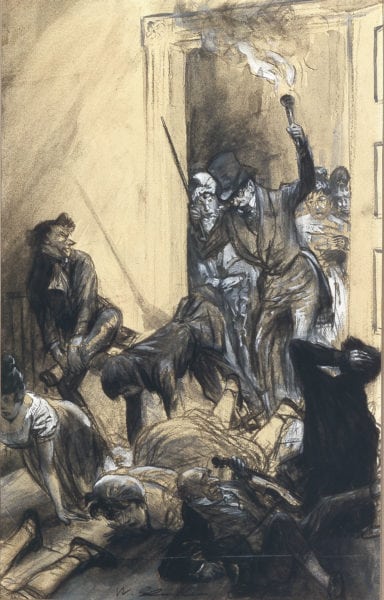M. Durand… Arrived on the Scene, 1903
William GlackensInk, wash, charcoal and Chinese white on paper
15 1⁄4 × 10 inches
Signed (at lower left): W. Glackens
In spite of the fortunate financial situation provided by his marriage in 1904, Glackens continued working as an illustrator, likely thriving on the diversity of executing works in various media and with different objectives. The years between 1899 and 1906 mark Glackens’ most prolific phase as an illustrator, in which he produced many superb works filled with vigor and a sense of immediacy. One of his major commissions, received in 1903, was to illustrate a compendium of grisette novels by the nineteenth-century French writer Charles Paul de Kock.
The drawing Monsieur Durand…Arrives on the Scene is one of the illustrations that the Glackens created for the first volume of C.P. de Kock’s novel Jean. The picture depicts a colorful tale of youthful mischievousness in middle-class Parisian life. In the story, Madame Durand decides that her son, the protagonist Jean, is destined to be an opera star; accordingly, she insists that he take music and dance lessons. An only child and somewhat spoiled, Jean vows to undermine his mother’s efforts, an undertaking which he successfully accomplishes one night at the weekly ball convened by his dancing-master, M. Mistigris, in his flat. While Mistigris is playing the prelude of the “Pantalon” and his company is dancing a quadrille of sixteen, Jean withdraws a fistful of fulminating peas from his pocket and throws them onto the dance floor. Even as the peas are still exploding and eliciting shrieks of fear from the ladies, Monsieur Durand suspects his son is the culprit and calls for the maid to stop Jean’s escape. The ensuing scene is represented in the drawing.
Unlike the images he produced for newspapers, which required from him firsthand observation, Glackens produced book illustrations from the story’s verbal clues, relying on his mastery of anatomical accuracy and keen awareness of distinctive personalities. M. Durand…Arrives on the Scene is a wonderful example of Glackens’ ability to discern and visually re-create eccentric temperaments. Rendered in the artist’s gritty, urban realist style, the picture is a witty, yet gentle caricature of both the lower and middle classes. The drawing focuses on a perplexed M. Durand who, brandishing a lit torch and waving his cane in the air, barges into the antechamber of the dancing-master’s apartment and encounters an unexpectedly frenetic scene. Shrouded in darkness, for Jean had previously blown out the candle, the characters that had one after another given chase to the young troublemaker are sprawled across the floor. M. Durand’s light reveals the cause of their dismay, two thick cords, unable to be detected in the darkness, had been strung across the room.
At the lower right, M. Mistigris fumbles on his back like a turtle trying to right itself, with his violin and bow still in hand. His right leg remains entangled with the cord, while his face expresses befuddled panic at the situation in which he finds himself. Immediately behind him, Madame Mouton, the most indefatigable of all the dancers and the obsequious mother of the three young ladies standing behind M. Durand, lies flat on her stomach with her ample backside high in the air; her pale face conveys shock and humiliation. At the far left, the maid Nanette rests on her hands and knees with her mouth wide open, aghast at her compromising position on the floor.
Glackens’ artistic style, characterized by swift, intuitive strokes, excellently captures the animated, unruly scene of Charles Paul de Kock’s story. In executing the drawing, the artist created an impressive range of tonalities by using ink, wash, charcoal and Chinese white. Delineating the scene with bold strokes of charcoal, the artist then endowed the figures with depth and shadows through his skillful use of ink wash and white color highlights. Ultimately, M. Durand…Arrives on the Scene exemplifies the artist’s keen talent for giving life to convincingly unique characters within a complex, multi-figure composition.
Literature
- Allyn, Nancy E. and Elizabeth H. Hawkes. William Glackens, A Catalogue of his Book and Magazine Illustrations. Wilmington, Delaware: Delaware Art Museum, 1987, no. 1004.
- This drawing was used as an illustration for de Kock, Charles Paul; St. Gervais, ed., Jean Boston: Quinby, 1903, vol. 1, p. 113.

